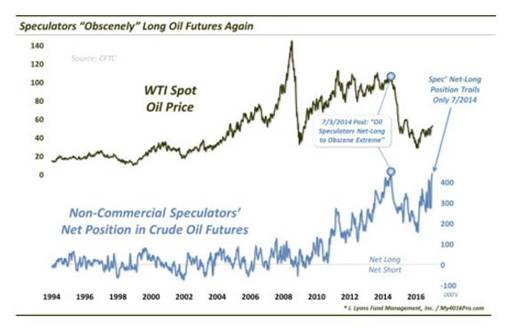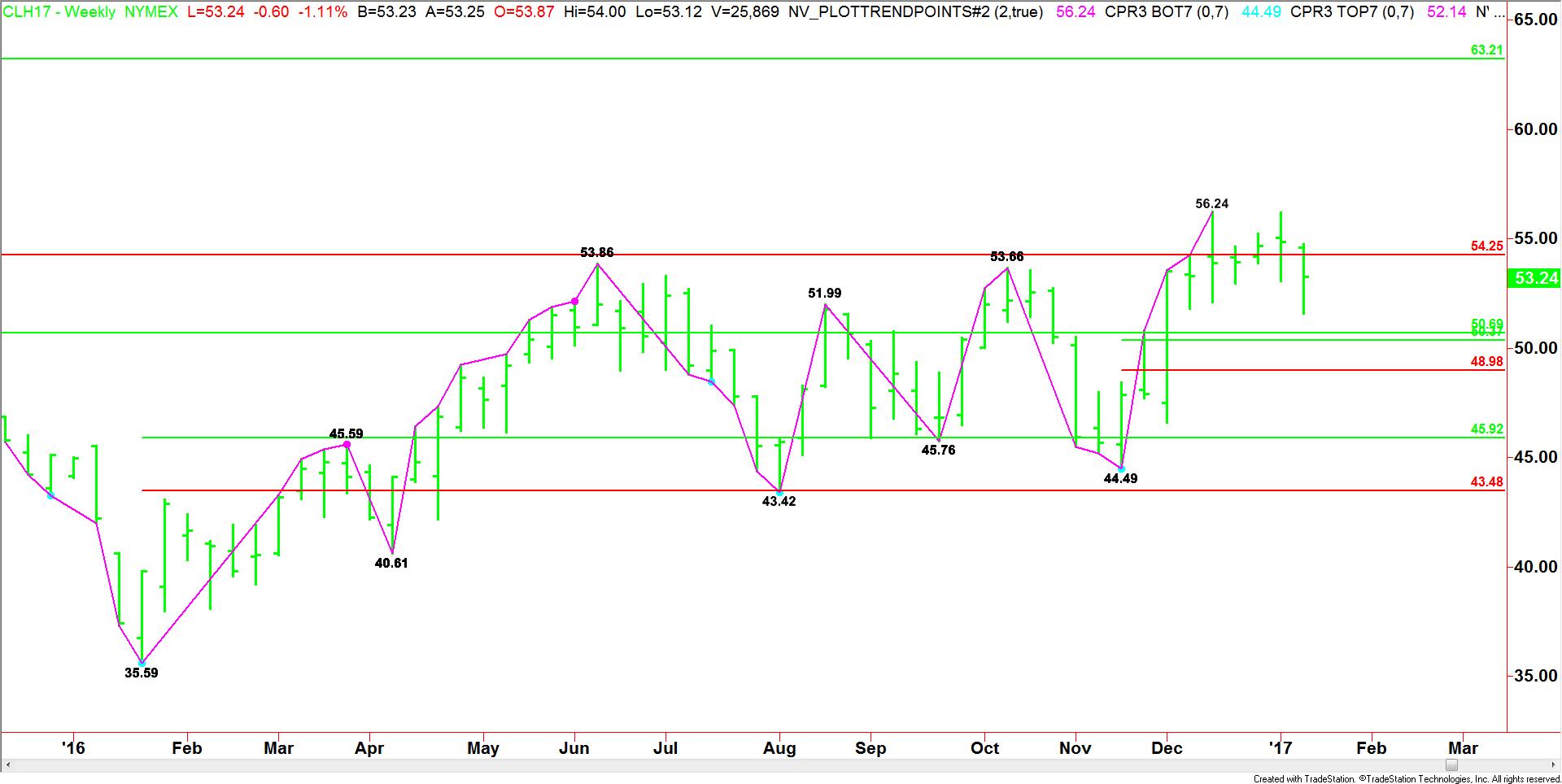Energy & Commodities
 If You Make a Grand Shorting Oil, It’s on Me!
If You Make a Grand Shorting Oil, It’s on Me!
Free.
And sufficiently timely, yes.
That’s what today’s idea is. Just remember, when you jump on today’s trade idea and make a grand, this one’s on me.
I’ve already begun preparing my paid subscribers with exact trade recommendations. But you can still act on this idea, because it is driven by key indicators that have performed well in the last 12 months.
The idea is that crude oil’s climb has maxed out.
Forever? Nah.
For the month? Likely.
For the year? Perhaps.
Basically, as I’ve been telling my paid subscribers for several weeks now, things are coming together in the crude oil market.
Unfortunately, they are converging to disappoint the bulls … at least for the time being.
I could make the case, technically, for crude oil to rise to around $60 per barrel before its fortunes turn sour in a negative feedback loop sort of way.
But things like sentiment surrounding the OPEC agreement, wave and Fibonacci analysis as well as speculators’ net long positioning all seem to suggest one thing.
That is, crude oil’s path of least resistance is quite clearly down.
And it’s this last point that I think deserves our attention.
I’ve talked about it before — many times — in these pages and others, how extreme positioning in the futures market can signal price reversals.
This seems particularly true for crude oil, where it has helped me and my subscribers identify a series of profitable trade opportunities.
And it seems the mainstream financial press is catching on to its forecasting worth.I found the following chart in a MarketWatch article:

speculators appear to be ‘obscenely’ long oil. Image credit: CFTC.
Amen!
This chart is telling us that large speculators have amassed an extreme net long position. One that rivals the 2014 peak when the price of crude oil collapsed.
(Note the blue dot in the upper-right corner of the image, which represents July 3, 2014. The image reads: “Oil Speculators Net-Long to Obscene Extreme.)
In other words, oil traders are super-bullish … and that’s a contrarian indicator.
Despite crude oil finishing off last week on a strong note, now would seem like an opportune time to short crude oil.
Of course, you can do that in the futures market if that’s your playground of choice.
Or you can sell short oil ETFs: the U.S. Oil Fund (USO) or shares of oil producers like ExxonMobil (XOM), for example.
Or you can purchase shares of inverse ETFs such as the DB Crude Oil Short ETN (SZO) that are designed to move up when the price of oil goes down.
And if you’re looking for some other ways to trade crude, I know two great ones.
You can buy put options on oil ETFs or oil producers. This will let you profit on downside in the price of oil and oil names … without having to pony up large amounts of margin to sell short the shares.
And if you have oil stocks and/or ETFs in your portfolio that you don’t want to part with, you can write call options against those securities if you think a top is in and you’d like to collect some cash payments from selling those calls.
Do right,
JR Crooks

 Here’s an overview of six of the ways nanotechnology uses are making a big difference in our daily lives.
Here’s an overview of six of the ways nanotechnology uses are making a big difference in our daily lives.
While there’s been plenty of focus on apps and cloud computing in the technology space, advances are also being made in hardware-focused sectors such as nanotechnology. Uses include everything from more efficient drug delivery systems to tiny transistors that allow for smaller and more powerful computer chips.
To be sure, the markets for nanotechnology products and nanotechnology uses are set to grow in the coming years. A report released this past December from Research and Markets states that nanotechnology “is a rapidly growing technology” and the global industry has been forecast to grow annually by 17 percent up to 2024.
Similarly, BCC Research has said that the global nanotechnology market was valued at $39.2 billion in 2016 and should grow at a CAGR of 18.2 percent, in order that the market will reach a believed $90.5 billion by 2021.
Still, for investors just starting to look at nanotechnology stocks, it can be difficult to know where to to begin, as nanotechnology uses are so varied. As a starting point, here’s an overview of six of the top areas in which nanotechnology uses are making a big difference today.
….Click below for description and stock recommendations:
Materials & Coatings
Medicine
Food
Electronics
Energy applications
Water and air treatment
…continue for

 If you think Mr. Trump is just blowing smoke when he rails against Washington’s bloated bureaucracy, you’d better sit down and brace yourself for a series of shocks …
If you think Mr. Trump is just blowing smoke when he rails against Washington’s bloated bureaucracy, you’d better sit down and brace yourself for a series of shocks …
Shock #1. The federal government’s complete failure to pass its audit: Just four days ago, the Government Accountability Office (GAO) released its full audit report covering fiscal year 2016 … and it’s a disaster:
The U.S. government failed the audit on about 34% of its assets.
This is crazy. When you run a public company, if your books are so botched up that your auditors refuse to give you a clean bill of health, it’s the kiss of death. But for the federal government, it’s routine; Uncle Sam has failed his audit in every single one of the past 20 years.
Here’s what’s new: Mr. Trump is the first president since Ronald Reagan with an explicit agenda to disrupt the status quo. Will that include a reorg that cleans up the mess? That remains to be seen. But if ever there was a president who has explicitly expressed the intent to tolerate some disruption for the sake of long-overdue fixes, Trump is it.
Shock #2. The messiest department of all: According to the GAO, the U.S. government department with THE sloppiest accounting and THE most waste of all is none other than … the Department of Defense.
This also happens to be one area where Mr. Trump, General Mattis and the Republican Congress are unanimously gung-ho — to invest the most money. But that also raises some urgent questions:
As they move to boost defense spending, will they also tackle the waste at the same time?
If so, what kind of disruptions will be needed to really make a dent?
What will be the impact on major defense contractors?
Will they actually do it?
Trump’s pre-election Tweet against Boeing denotes a keen awareness of the problem. But the nightmarish logistics of cost-cutting indicate that he may first have to focus on the defense build-up, and only secondarily on the complex, time-consuming fixes that are sorely needed.
Shock #3. The government is the biggest enterprise on Earth: Well, maybe this is not such a shock to you. But even though you may be aware of the problem in general terms, it’s still shocking when you consider the numbers:
- The U.S. federal government employs a whopping 3.2 million people.
- India’s population is now over 1.335 trillion. Take away the entire trillion, and it’s still larger than America’s. But India’s biggest single enterprise, the Indian Armed Forces, employs “only” 1.4 million; and its second largest, the Indian Railways has “only” 1.3 million. Even combined, they have fewer employees than the U.S. government.
- In China, the largest single enterprise is the People’s Liberation Army. With China’s massive defense build-up in recent years, you’d think it would be larger than the U.S. government. But with 2.3 million, it’s far from it.
- Walmart, with more than 5,000 stores in the United States and Puerto Rico, is America’s largest private employer. Finding someone in the store to help you may often be a challenge, but there are actually quite a few employees around — over 2 million! Nevertheless, Walmart is also much smaller than the U.S. government.
Needless to say, all this is quite a change from the days of George Washington, when the federal government employed just a handful of people in three small departments — State, Treasury and War.
Can Mr. Trump turn around, stop, or at least slow this massive, centuries-long trend of government expansion? I think it’s possible. But to the degree he can truly shake things up, the side effects are bound to be painful.
 Shock #4. Unintended consequences: Everyone on Wall Street knows WHAT Trump and Congress have promised to do: They want to get tougher on trade deals, lift regulations, cut taxes, repeal Obamacare, restore the nation’s infrastructure and more.
Shock #4. Unintended consequences: Everyone on Wall Street knows WHAT Trump and Congress have promised to do: They want to get tougher on trade deals, lift regulations, cut taxes, repeal Obamacare, restore the nation’s infrastructure and more.
Everyone also knows WHEN these changes will begin: Soon after Inauguration, just four days from today.
What virtually NO ONE on Wall Street can tell you is what the unintended consequences will be. They don’t know if trade wars will be triggered. They don’t know what the impact will be on the federal budget. They don’t know how America’s adversaries will react or how the U.S. government will react to those reactions. They certainly don’t know exactly how investors will respond or when.
We don’t either. Nor do we need to. Indeed, it’s precisely at times like these that our investment strategies, perfected over decades of political and market turmoil, become such valuable assets.
Larry Edelson, for example, didn’t need a PhD in political science to predict that Donald Trump would win the election. Instead, he used his deep knowledge of historical cycles, based on thousands of years of data, to correctly predict the outcome. Nor did he need a crystal ball to predict the housing bust of 2007, the Great Debt Crisis of 2008, the Fed’s wild money printing of 2008-2016 and every major move in gold since the 1980s. Cycles showed him the way.
This also helps explain why Larry’s subscribers are looking at open gains of 207% in gold bullion, as much as 167% in SPDR Gold Shares, and from 10% to 38% in four related investments recommended just last year, just to mention a few.
 Similarly, our editor Jon Markman didn’t need to be an Einstein Fellow to predict when the tech sector would rise or fall. Instead he relied on his robust forecasting model that has proven itself through some of the most disruptive market gyrations of all time. End result: Overall portfolio growth of more than 25% in 2016, including all losing trades.
Similarly, our editor Jon Markman didn’t need to be an Einstein Fellow to predict when the tech sector would rise or fall. Instead he relied on his robust forecasting model that has proven itself through some of the most disruptive market gyrations of all time. End result: Overall portfolio growth of more than 25% in 2016, including all losing trades.
Better yet, right now, after years of testing and validation, Jon has just launched a new investment approach based on a trading technology developed in the 1930s by one of my father’s contemporaries — Jesse Livermore. Until now, no one, not even my father who tracked his trades in real time, was able to decode Livermore’s timing indicator. But Jon has.
 Meanwhile, our editors Boris Schlossberg and Kathy Lien use a simple device that was created 354 years before boomers like Mr. Trump (and me) were born: The Gregorian Calendar.
Meanwhile, our editors Boris Schlossberg and Kathy Lien use a simple device that was created 354 years before boomers like Mr. Trump (and me) were born: The Gregorian Calendar.
I could fill volumes with these success stories. And I could also tell you a story or two about editors who sometimes go through slumps. But suffice it to say that all of us at Weiss Research are completely ready for the indisputable outcome of the Trump presidency:
The incoming administration will shake Washington and Wall Street to its core. It will precipitate a sea change unlike anything in living memory, sometimes for the better, sometimes not, driving some markets sharply higher, others sharply lower.
I repeat: Many people can tell us WHAT the Trump presidency will change and even when those changes will begin. But we are among the very few who can tell you with disciplined objectivity and relative confidence, how to deal with the impact — on stocks and stock sectors, interest rates, gold and silver, foreign currencies, options, plus much, much more.
Good luck and God bless!
Martin

1. Gold’s fate as Western society cracks apart …
by Larry Edelson
Right now, gold is still caught in a trading range, but with a long-term bias toward exploding higher over the next few years to at least $5,000 an ounce.
2. Massive VIX Warning for all Traders
by John Winston
My analysis of the recent VIX action is clearly warning of a potentially massive price volatility increase in the US and global markets.
3. The 27 most important finance books ever written
“In my whole life, I have known no wise people (over a broad subject matter area) who didn’t read all the time — none,” Charlie Munger, the vice chairman at Berkshire Hathaway, once said.
With that in mind, we’ve highlighted 27 classic works that every Wall Streeter should read.

It’s been an up and down week for crude oil futures with the price action playing out as expected. Going into the new year, we were looking for a choppy, two-sided traded largely because of the uncertainty regarding compliance with the OPEC/Non-OPEC plan to cut production, trim supply and return price stability to the market.
On the upside, we expected prices to be capped by rising U.S. production, while on the downside, prices were expected to be supported by reports that countries who had agreed to limit production would announce compliance with the plan. Based the price action this week, we can conclude that we’ve seen a little of both.
Weekly West Texas Intermediate Crude Oil
The main trend is up according to the weekly swing chart. However, momentum has been sideways for the last four weeks. A trade through $56.24 will signal a resumption of the uptrend. A trade through $44.49 will change the trend to down.
Given the average weekly range, it’s pretty safe to say the uptrend is safe next week.
The major 50% to 61.8% retracement zone is $50.69 to $54.25. The market is currently straddling this zone and to be specifically, it is straddling the Fibonacci level at $54.25.
Based on the price action since December 16, the direction of March Crude Oil next week will be determined by trader reaction to the Fib level at $54.25.
Bearish Scenario
A sustained move under $54.25 will indicate that momentum is shifting to down. This could trigger a break into a 50% support cluster at $50.69 to $50.37. Since the main trend is up, we could see enough buyers come in on a test of this level to trigger a technical bounce.
If enough buyers come in at $50.69 to $50.37 then look for the formation of a secondary higher bottom. This may mean that traders are setting up to make a run at $56.24 over the near-term. If support fails at $50.37 then look for the selling to extend into $48.98.
The short-term Fib at $48.98 is very important to the structure of the chart pattern. If it fails then look out to the downside because the next major support doesn’t come in until $45.92 to $43.48.
Bullish Scenario
Overcoming $54.25 will indicate the presence of buyers. This could generate enough upside momentum to challenge the high at $56.24. This price is the trigger point for the start of a strong rally with the next likely target $63.21 over the near-term.
Conclusion
I think we’ve seen enough price action and order flow over the past month to conclude that trader reaction to $54.25 will tell us if the bulls are maintaining control or if the sellers are taking control.
Despite the uptrend on the weekly chart, the eye test tells us that March WTI Crude Oil is rangebound. On the support side, it is being held up by expectations that the OPEC/non-OPEC deal to curb production will attract 100% compliance. The OPEC spin machine is also peppering the news with positive stories.
The market, however, is being capped and perhaps taken over by worries about increased U.S. production. In my opinion, all it is going to take is only one negative story about non-compliance with the plan to trim production to trigger a steep sell-off.
This is likely to come from the meeting to be held in Vienna on January 21 to 22. Look for the market to chop around next week, but start preparing for bearish news if the meeting reveals less than 100% compliance and evidence of cheating.













